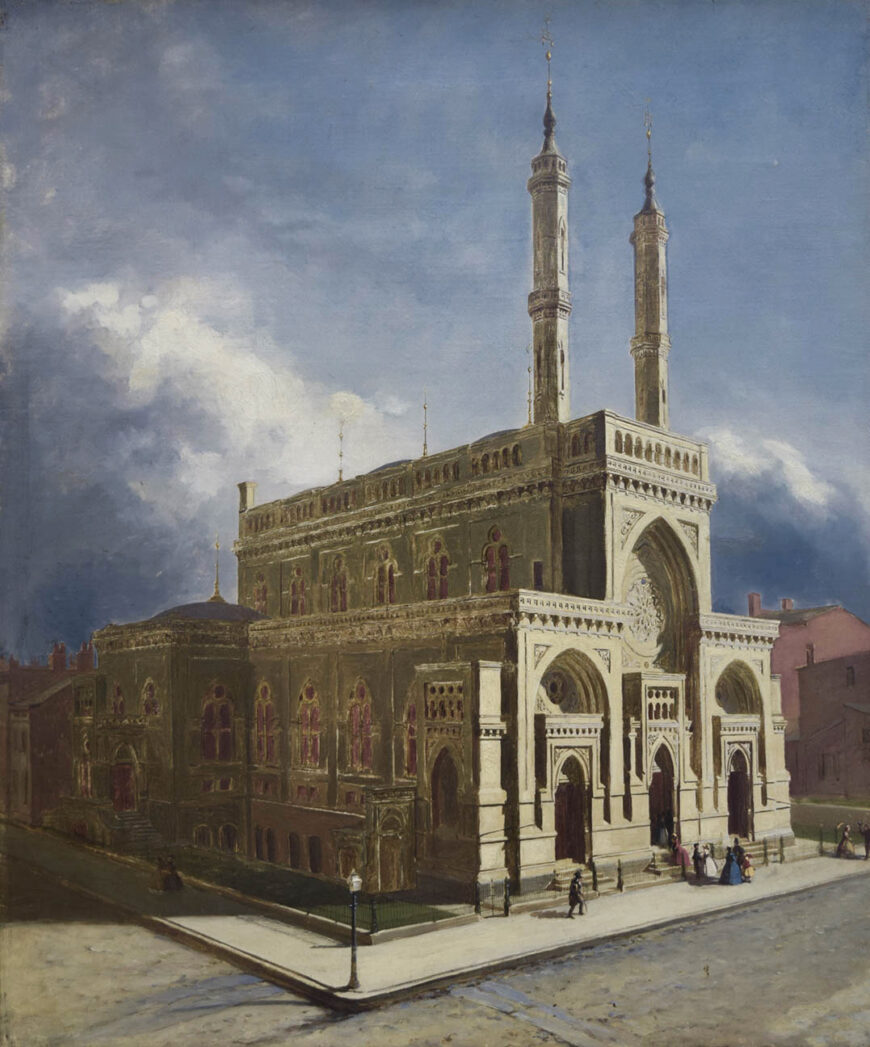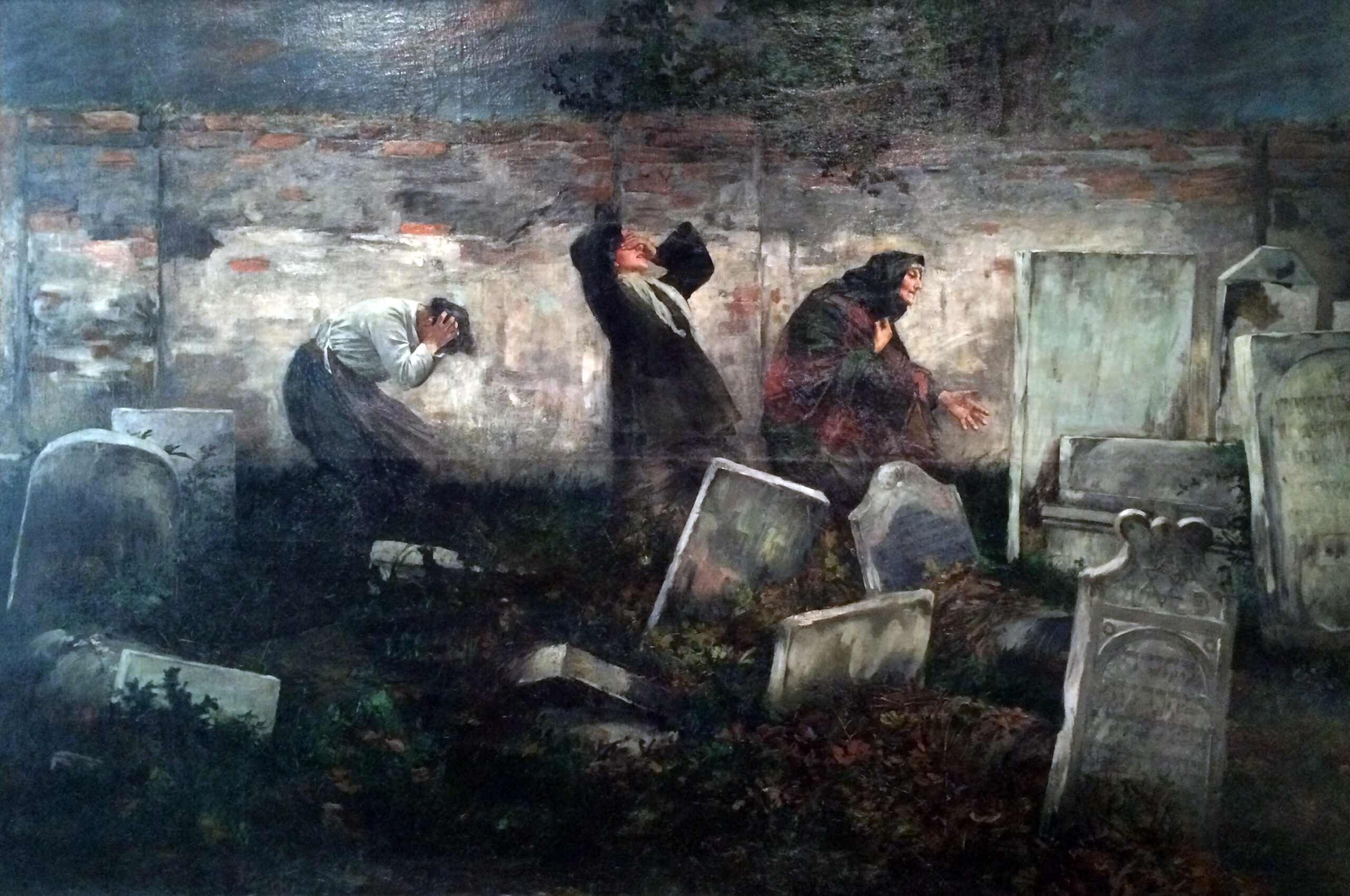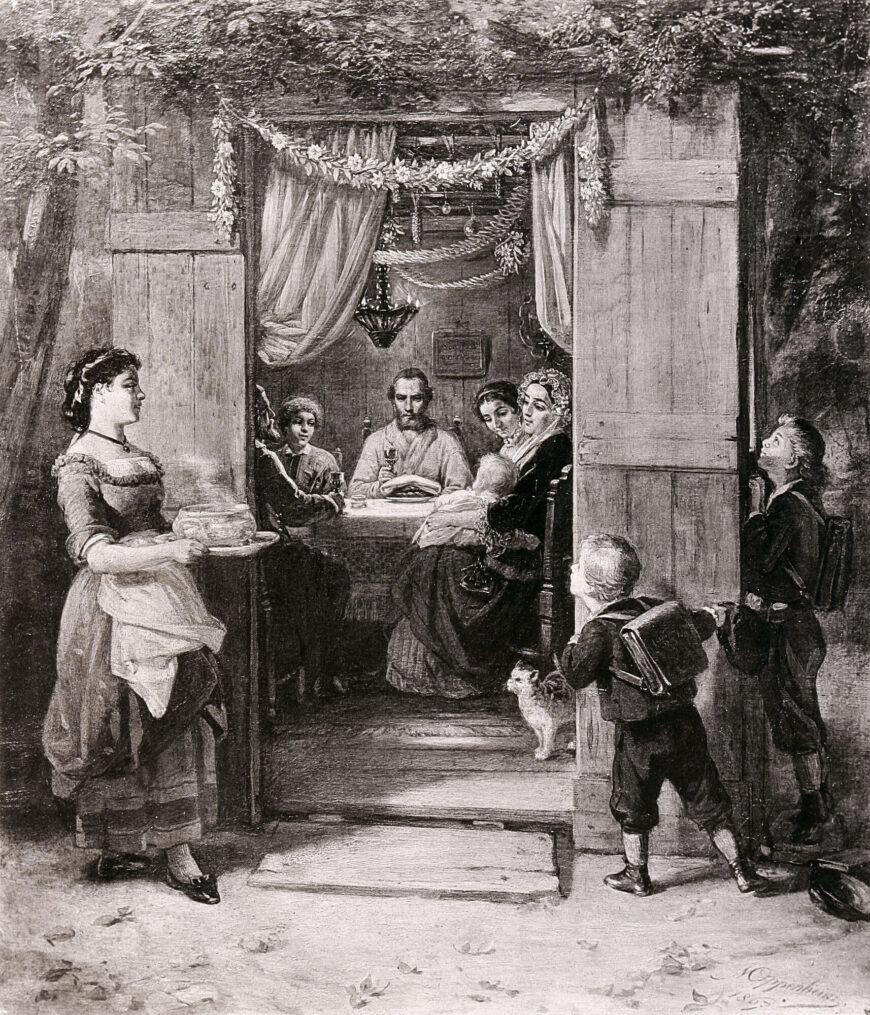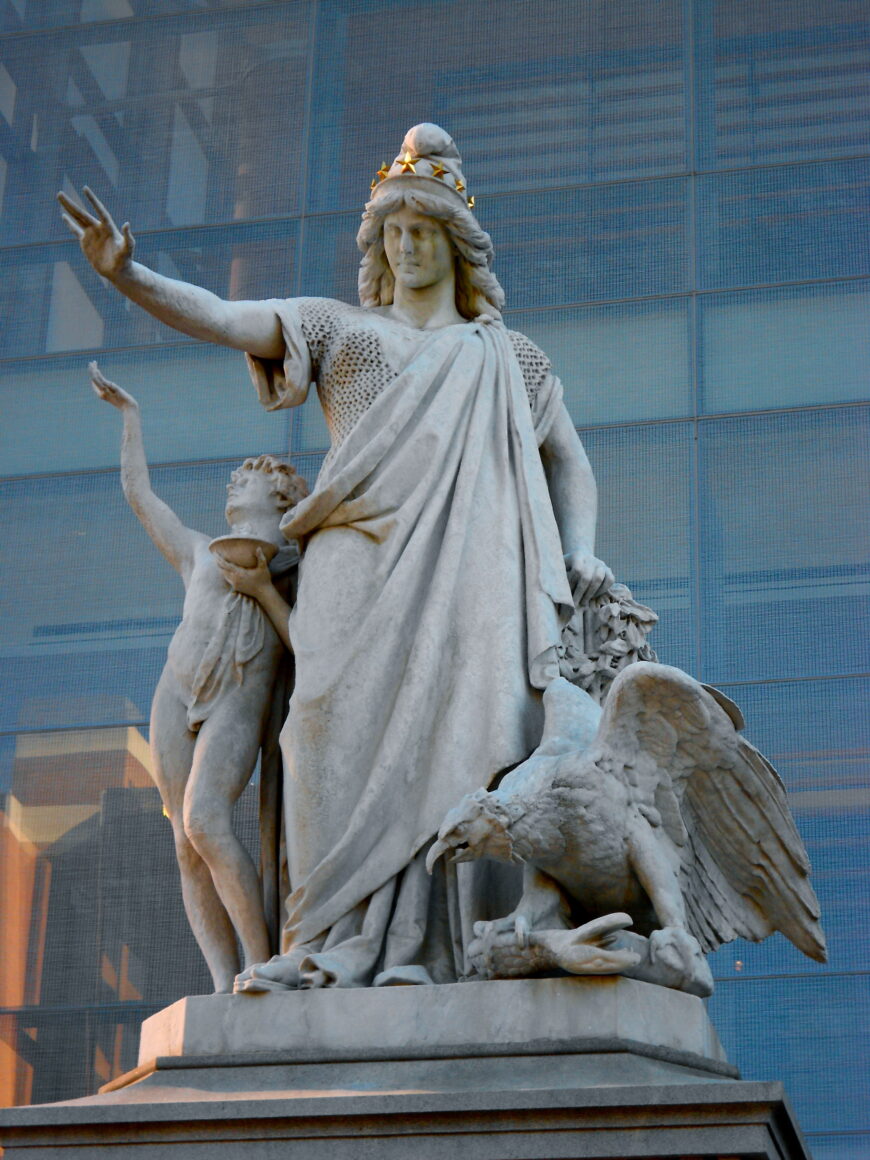
Henry Mosler, Plum Street Temple, 1866, oil on canvas, 92.1 x 79.4 cm, Cincinnati (Cincinnati Skirball Museum)
While Jews arrived in the United States as early as 1654, they did not enter the visual arts in a meaningful way until the nineteenth century. The freedoms accorded Jews in America, subjected for centuries to antisemitism and exclusion in Europe, enabled them to participate in the visual arts. Yet for some Jews, the loosening of religious constraints as well as uneasiness about the respectability of an art career disappeared slowly. Hesitancy was sometimes the result of the Second Commandment—the prohibition against graven images. Interpreted stringently, as it was for centuries, the Second Commandment has been misunderstood as prohibiting the creation of art: “Thou shalt not make any graven image, or any likeness of any thing that is in the heaven above, or that is in the earth beneath, or that is in the water under the earth” (Ex. 20:4). Close reading of the text shows that the commandment was directed against creating images (of human beings or animals) that would be used for idol worship, not other types of artistic expression. Regardless, the Second Commandment did not preclude art entirely. In the Book of Exodus, Bezalel—the first Jewish artist—designed the Tabernacle and its holy vessels (Ex. 35:31).
Jewish art was made in ancient times (before c. 400 C.E.), albeit rarely. For example, human renderings appear in the third-century synagogue murals of Dura Europos in Syria and in synagogue floor mosaics across the Galilee and North Africa. Their rarity was more likely a result of the Jews’ diasporic lifestyle (and therefore their inability to transport art that was not portable), than a literal understanding of the biblical text. Jews may have been focused on studying the Torah, which is considered the most vital pursuit in Judaism, and so time for creating pictorial art was scarce.

Myer Myers, Pair of Torah Finials from the Touro Synagogue, 1766–76, silver and brass with parcel gilding, 36.8 cm high (Museum of Fine Arts, Boston)
There are few known Jewish artists in Colonial America. Eighteenth-century New York silversmith Myer Myers made both lay and religious objects, acceptable under strict adherence to the Second Commandment, for colonial merchants. Myers’s designs range from engraved teapots to a few surviving Jewish ceremonial objects, a rare early case of a known Jewish craftsman of Judaica. His elaborate Torah finials ornamented the holy scrolls in the ark for several synagogues, including Touro Synagogue in Newport, Rhode Island, the oldest congregation in the United States. More often at this time, Christians made Judaica. Nor did Jews actively create paintings and prints of Jewish life, as they would soon do. Rather, Christians depicted Jewish existence, often featuring Jews as objects of fascination and even derision.
Early Jewish American artists mostly worked independently and were not readily known to each other. They worked in divergent styles and genres, usually along the trends of the artistic mainstream. It was not until the twentieth century that Jewish American artists began to regularly interact and take art classes together—most notably at the Educational Alliance, a settlement house on the Lower East Side—and when they did, their prominence belies their small numbers. If one were to try to find even a few commonalities among the distinct group of early Jewish artists described here, then one could point to a cosmopolitan group who often traveled to Europe for artistic training and sometimes remained for long periods, although this trajectory is not unique to artists of that generation as a whole. They also tended to congregate in cities populated by Jews.

Samuel Hirszenberg, The Jewish Cemetery, 1892, oil on canvas, 198 x 296 cm, Munich (Musée d’Art et d’Histoire du Judaïsme)
European Jewish contemporaries

Moritz Daniel Oppenheim, “Feast of Tabernacles” from Scenes from Traditional Jewish Family Life, 1869, heliogravure, 47.5 x 32 cm (Jewish Museum Frankfurt)
Of greater salience is that nineteenth-century Jewish American artists did not face obstacles because of their religion and were afforded the same opportunities as their non-Jewish peers. Neither were these artists confined by their Jewish roots—they did not feel compelled by their Jewish identity to make works of an overtly Jewish nature, nor were they dependent on Jewish patronage—although they benefited from that support. In these ways, Jewish Americans strongly differ from their European Jewish contemporaries, who were navigating political, religious, and social upheavals that found expression in art. Samuel Hirszenberg, for example, painted a Jewish lament to European persecution in The Jewish Cemetery. Women grieve, with melodramatic gestures, amid neglected and even desecrated tombstones. Other European artists of the same period took a nostalgic turn to Jewish life rapidly disappearing. Moritz Daniel Oppenheim portrayed Jewish life as idyllic in genre paintings representing the major customs and holidays of the Jewish year and Jewish life-cycle. In his later career, Oppenheim began to reproduce those paintings in a series of grisaille (gray tones) images to reach a wide audience. First published in 1866 and in subsequent editions, the series decorated Jewish-German homes in remembrance of a vanishing Jewish past and was also meant to educate Christians about Jews.
Categorizing “Jewish artists”

Moses Jacob Ezekiel, Religious Liberty, 1876, marble, 3.4 m high, Philadelphia (photo: Smallbones, CC BY-SA 3.0)
Examination of American Jewish artists is long overdue, not because they are “Jewish artists,” per se, because most of them would not want to be categorized as such, but because they made intriguing, unfairly forgotten work that enriched the American cultural landscape. Moses Jacob Ezekiel, the artist most connected to his heritage as well as the most distinguished of the era, was adamant about avoiding the categorization “Jewish artist”:
I must acknowledge that the tendency of the Israelites to stamp everything they undertake with such an emphasis [as Jewish art] is not sympathetic with my taste. Artists belong to no country and to no sect—their individual religious opinions are matters of conscience and belong to their households and not to the public. In reference to myself, this is my standpoint. Everybody who knows me knows that I am a Jew—I never wanted it otherwise. But I would prefer as an artist to gain first a name and reputation upon an equal footing with all others in art circles. It is a matter of absolute indifference to the world whether a good artist is a Jew or a Gentile and in my career I do not want to be stated with the title of ‘Jewish sculptor.’[1]
It is crucial, though, to address the influence of these artists’ Jewish identity on their art, much as art historians look at the influence of identity on women artists and artists of color. Certainly not all, or even most, of the work reflects the artists’ religio-cultural heritage, but some surely does. Accordingly, as the accepted canon rightly continues to expand, we should interrogate art made by Jewish Americans—discerning whether Jewishness is overt or implied—as art history continues to integrate the experiences of artists outside of traditional norms.

